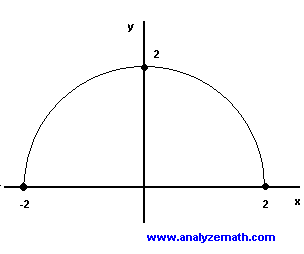Graphing Square Root Functions
A step by step tutorial on graphing and sketching square root functions
. The graph, domain, range and sometimes the simplifications of these functions and other properties are discussed.
Review
The domain of function f defined by \( f(x) = \sqrt{x} \) is the set of all real positive numbers and zero because the square root of negative numbers are not real numbers (think of \( \sqrt{- 4} \), is it real?).
In inequality form, the domain of \( f(x) = \sqrt{x} \) is written as
\[ x \ge 0 \]
in interval form the domain is given by
\[ [ 0 , + \infty) \]
Example 1
Make a table of values of function f given below, graph it and find its range.
\[ f( x ) = \sqrt{x} \]
Solution to Example 1
Because the domain of \( f \) is the set of all positive real numbers and zero, we might construct a table of values as follows:
\[
\begin{array}{|c|c|c|c|c|c|}
\hline
\mathbf{x} & 0 & 1 & 4 & 9 & 16 \\
\hline
\sqrt{x} & 0 & 1 & 2 & 3 & 4 \\
\hline
\end{array}
\]
The values of x were selected so that the square root of these values are whole numbers which make it easy to plot the points shown in the table.

The range of \( f \) is given by the interval \[ [0 , +\infty) \]
Example 2
Find the domain, make a table of values of function f given below, graph it and find its range.
\[ f( x ) = \sqrt{x - 3} \]
Solution to Example 2
First find the domain of the square root function given above by stating that the expression under the square root must be positive or equal to zero
\[ x - 3 \ge 0 \]
Solve the above inequality to obtain the domain of \( f \) as the set of all real values such that
\[ x \ge 3 \]
We now select values of x in the domain to construct a table of values.
\[
\begin{array}{|c|c|c|c|c|}
\hline
x & 3 & 4 & 7 & 12 \\
\hline
\sqrt{x - 3} & 0 & 1 & 2 & 3 \\
\hline
\end{array}
\]

The interval \( [0 , +\infty) \) represents the range of \( f \).
Example 3
Find the domain, make a table of values of function f given below, graph it and find its range.
\[ f( x ) = - \sqrt{- 2x + 4} + 1 \]
Solution to Example 3
The domain of the function given above is found by setting
\[ - 2x + 4 \ge 0 \]
Solve the above inequality to obtain the domain of f as the set of all real values such that
\[ x \ge 2 \]
We now select values of x in the domain of f to construct a table of values. These values are selected so that the square root term is a whole number and give points that are easy to plot.
\[
\begin{array}{|c|c|c|c|c|c|}
\hline
x & 2 & \dfrac{3}{2} & 0 & -\dfrac{5}{2} & -6 \\
\hline
- \sqrt{-2x + 4} + 1 & 1 & 0 & -1 & -2 & -3 \\
\hline
\end{array}
\]

The range of f is given by the interval \[ (-\infty , 1] \].
Example 4
Find the domain of function f given below, graph it and find its range.
\[ f( x ) = \sqrt{- x^2 + 4}\]
Solution to Example 4
The domain of function given above is found by solving the polynomial inequality
\[ - x^2 + 4 \ge 0 \]
The solution set of the above inequality is given by the interval
\[ [-2 , 2] \]
which is also the domain of the above function.
Let us write the given function as an equation as follows
\[ y = \sqrt{- x^2 + 4} \]
Square both sides and arrange to obtain.
\[ x^2 + y^2 = 2^2 \]
The equation obtained is that of a circle. Hence the graph of \( f(x) = \sqrt{- x 2 + 4} \) is the upper half of a circle sinsce \( \sqrt{- x^2 + 4} is positive. Hence the graph below.

The interval \( [0 , 2] \) represents the range of \( f \).
Example 5
Find the domain, make a table of values of function f given below, graph it and find its range.
\[ f( x ) = \sqrt{x^2 - 9} \]
Solution to Example 5
The domain of the function given above is found by solving
\[ x^2 - 9 \ge 0 \]
Which gives a domain reprsented by
\[ (-\infty , -3] \cup [3 , +\infty) \]
We now select values of x in the domain of \( f \) to construct a table of values, noting \( f(x) = f(-x) \) hence a symmetry of the graph with respect to the y axis.
\[
\begin{array}{|c|c|c|c|}
\hline
\textbf{x} & 3 & 5 & 8 \\
\hline
\sqrt{x^2 - 9} & 0 & 4 & 7.4 \\
\hline
\end{array}
\]

The range of \( f \) is given by the interval \[ [0 , +\infty) \].
Example 6
Simplify \( f(x) \) given below, graph f and find its range.
\[ f( x ) = \sqrt{x^2 - 6x + 9} \]
Solution to Example 6
Let us use write the expression under the square root as a square as follows
\[ x^2 - 6 x + 9 = (x - 3)^2 \]
Hence
\[ f( x ) = \sqrt{x^2 - 6x + 9} \]
which may be written
\[ f( x ) = \sqrt{ (x - 3)^2 } = | x - 3 | \]
The given function has been rewitten as an absolute value function. Function f may be written as a piecewise function and graphed as follows.

The range of f is given by the interval \[ [0 , +\infty) \]






